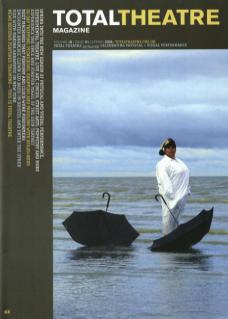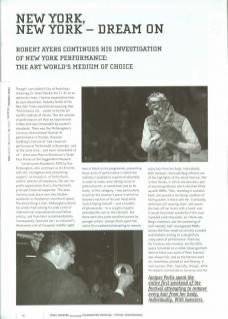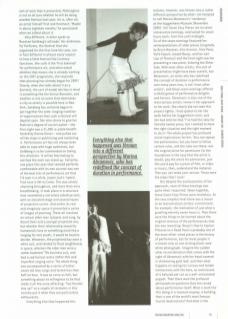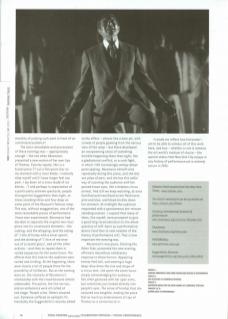Though I concluded ‘A City of Ambitious Dreaming’ (in Total Theatre Vol 17-4) on an optimistic note, I had no expectation that by early November, Roberto Smith of the New York Times would be announcing that ‘Performance art... seems to be the art world's medium of choice.' But the autumn of performance art that we experienced in New York was remarkable by anyone's standards. There was Dan McKereghan's Currency international festival of performance in October, RoseLee Goldberg's festival of 'new visual art performance’ Performa05 in November, and at the same time – and most remarkable of all – there were Marina Abramovic's Seven Easy Pieces at the Guggenheim Museum
Currency was founded in 2002 by Dan McKereghan, who continues as its director, with the ‘courageous and unwavering support', as he puts it, of Anita Durst, artistic director of chashama, the not-for-profit organisation that is the festival's principal financial supporter. This year, Currency took place over two October weekends in chashama's store-front space. The whole thing is free. McKereghan selects his artists from among his wide circle of international acquaintances and fellow artists, and from their recommendations. Consequently (and who am I to criticise?), there were a lot of European middle-aged men in black on his programme, presenting those sorts of performance in which the ordinary is pushed to a point of absurdity in order to make some telling social or political point, or sometimes just to be funny. In this category, I was particularly struck by Uto Gusztav's piece in which he shaved a section of his own head while Scotch Taping himself – and a handful of phonecards – to a couple of public phonebooths out on the sidewalk. But there were also some excellent pieces by younger artists. Juniper Perlis spent the entire first weekend attempting to remove every hair from her body. Individually. With tweezers. Gertrude Berg offered one of the highlights of the whole festival, Not in Your Hands, in which she donned a pair of outsize gumboots which she then filled up with M&Ms. Then, standing in a plastic bath, she poured a terrifying cauldron of boiling water in there with her. Eventually, while was still wearing them, she sawed the toes off her boots with a hand-saw. It would have been wonderful if this had revealed solid chocolate, as I think was Berg's intention, but the scattering of half-melted, half-recongealed M&Ms across the floor made an entirely suitable and bathetic ending to a delightfully crazy piece of performance. Publicity for Currency was minimal, yet the little space (situated on a rather bleak garment district block just north of Penn Station) was always full, and as the festival wore on, sometimes packed to overflowing. A real success, then. Typically, though, while he remains committed to Currency and the sort of work that it presented, McKereghan is not at all sure whether he will be doing another festival next year. He is, after all, an artist himself first and foremost: ‘Maybe in about eighteen months,' he speculated when we talked about it.
Very different, in other words to RoseLee Goldberg's attitude. Her ambitions for Performa, the festival that she organised for the first time this year, are in fact different in almost every respect to how a little festival like Currency functions. She calls it the 'first biennial for performance art’, and when asked whether that means she is already working on the 2007 programme, she responds that planning has already begun for 2009! Clearly, when she talks about it as a biennial, the sort of model she has in mind is something like the Venice Biennale, and whether or not an event that dominates a city so utterly is possible here in New York, Goldberg has certainly begun to put together the wide-ranging coalition of organisations that such a festival will depend upon. She also strove to give her festival a degree of social cachet – the first night was a $1,000-a-plate benefit hosted by Donna Karan – and pulled out all the stops in publicising and marketing it. Performance art has not always been able to cope with huge audiences, but Goldberg is to be commended on taking this direction. It will be fascinating to see how the work can stand up. Certainly one piece this year that seemed perfectly comfortable with its own success was one of the best bits of performance art that I'd seen in a while, Jesper Just's 'opera' True love is yet to come. This was utterly charming throughout, and more than once breathtaking. It took place in a structure that resembled a red velvet sideshow tent, with an elevated stage and several layers of projection scrims. And within its real and imaginary space it presented a series of images of yearning. These all involved an actual older man (played, and sung, by Baard Owe) and a younger projected one; but whether their relationship stood for homoerotic love or something more like a longing for lost youth, it would be hard to decide. Whatever, the projected boy wore a white suit, and tended to float weightlessly in space, whereas the older man wore a rather battered '70s business suit, and had a sad haircut and a rather thin and imperfect singing voice. The whole thing was accompanied by a series of bittersweet old love songs and lasted less than half an hour. It was as corny as hell, but something about its willingness to be that made it all the more affecting: 'Two thumbs way up!' as a couple of reviewers in this country put it when they are particularly enthusiastic.
Everything else that happened this autumn, however, was thrown into a rather different perspective by what I am tempted to call Marina Abramovic's residency at the Guggenheim Museum (November 2005). Her Seven Easy Pieces ran on seven consecutive evenings, and lasted for seven hours each, from five until midnight. Six of the seven evenings featured her reinterpretations of older pieces (originally by Bruce Nauman, Vito Acconci, Gina Pane, Valie Export, Joseph Beuys, and her own Lips of Thomas) and the final night saw her presenting a new piece, Entering the Other Side. With most other artists, this sort of presentation might have been overkill, but Abramovic, an artist who has redefined the concept of duration in performance over many years now, is not 'most other artists', and these seven evenings offered a whole gamut of performative delights and horrors. Abramovic is also one of the most serious artists I know in her approach to her work. She clearly did not take this project lightly. I had spoken to her the week before her Guggenheim stint, and she had told me that ‘I've had this idea for literally twelve years, but I wanted to have the right situation and the right moment to do it.' The whole project has profound moral implications for her: 'You can repeat the performance, but you have to follow certain rules, and the rules are these: ask the original artist for permission (or the foundation in the case that the artist is dead); pay the artist for permission, just like you'd pay for a piece of film, or video or music; then, understand the material. Then you can make your version. Those were the steps that I took.'
But despite the assiduousness of her approach, none of these evenings was quite what I expected. Taken together, these Seven Easy Pieces were revelatory. At the very simplest level there was a lesson to be learned about artistic commitment: for example, the realisation of just what a gruelling eternity seven hours is. Then there were the things to be learned about the original versions of the performances that she was reworking: Beuys' How to Explain Pictures to a Dead Here is probably one of the most often-cited pieces in the history of performance, but for most people it is known only as one striking black-and-white photograph. Imagine the sudden utter reconsideration that comes with the sight of Abramovic with her head covered in shimmering gold leaf, and then what happens on seeing her curious and tender interactions with the hare, as reminiscent of a beloved pet cat as a well-articulated puppet. Then there were the profound philosophical questions that she raised about performance itself: What is work like this doing in a museum anyway, a building that is one of the world's most famous tourist destinations? And what is the morality of putting such work in front of an uninitiated audience?
The most remarkable and provocative of these evenings was – appropriately enough – the one when Abramovic presented a new version of her own Lips of Thomas. Even by repute, this is a brutal piece ('I cut a five point star on my stomach with a razor blade. I violently whip myself until I no longer feel any pain. I lay down on a cross made of ice blocks...’) and perhaps in expectation of a particularly extreme spectacle, people thronged the Guggenheim that night, at times standing three and four deep on some parts of the Museum's famous ramp. This was, without exaggeration, one of the most remarkable pieces of performance I have ever experienced. Abramovic had decided to separate the original two-hour piece into its constituent elements – the cutting, and the whipping, and the eating of ‘1 kilo of honey with a silver spoon', and the drinking of '1 litre of red wine out of a crystal glass', and all the other actions – and then to repeat them in varied sequences for the seven hours. The effects that this had on the audience were varied and striking. At the beginning, there were clearly a lot of people there for the possibility of titillation. But as the evening wore on the intensity of Abramovic's relationship with the crowd became almost unbearable. The police, the fire service, and an ambulance were all called at one stage. People cried. Others shouted out. Someone suffered an epileptic fit. Inevitably the Guggenheim's rotunda added to the effect – almost like a bear pit, with crowds of people gawking from the various tiers of the ramp – but there developed an overpowering sense of something horrible happening there that night, like a gladiatorial conflict, or a cock fight, in which I felt increasingly uneasy about participating. Abramovic herself cries repeatedly during this piece, and she lets out yelps of pain, and she has this awful way of scanning the audience with her pained brown eyes, like a helpless circus animal. And still we keep watching, at once horrified and transfixed as her flesh turns pink and blue, and blood trickles down her stomach. At midnight the audience responded with a spontaneous ten-minute standing ovation. I suspect that many of them, like myself, were prompted to give a good long reconsideration to the whole question of self-harm as a performative device (and thus to vast swathes of the history of performance art). That is how important the evening was.
Abramovic's new piece, Entering the Other Side, presented the next evening, offered a marvellous celebratory response to these horrors. Appearing twenty feet tall, and wearing a huge deep-blue dress the size and shape of a circus tent, she spent the seven hours simply acknowledging her audience. She often gestured with her open arms, but sometimes just looked directly into people's eyes. The sense of kinship that she conjured was tangible, making the piece feel as much an endorsement of Lips of Thomas as a corrective to it.
It made me reflect how fortunate I am to be able to witness all of this work here, and how – whether or not it remains the art world's medium of choice – the special status that New York City enjoys in any history of performance art is entirely secure in 2006.
Roberto Smith quoted from the New York Times, www.nytimes.com
The article mentioned can be accessed via http://tinyurl.com/9558
Currency International festival of performance: www.chashama.org/currency/cOxindex.htm
Chashama: www.chashama.org/home.php
PERFORMA05: www.performa-arts.org
Guggenheim Museum: www.guggenheim.org/new_york_index.shtml



